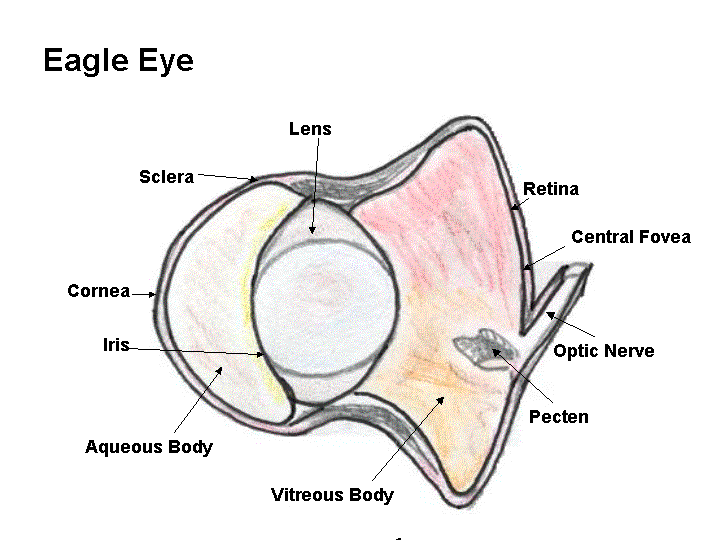Introduction
“You have an eye like an eagle.” “Use your eye like you're an eagle.” Have you ever heard those metaphors? Here in this website, we will be uncovering every detail of the eagle eye, inside and out. We would like to enhance your knowledge on the eagle eye and we you leave this website knowing a lot more information than you did when you entered it. What are we going to tell you that will make your head explode with facts? Well,
first, we will be explaining the interior and exterior parts of the eagle eye.
Then, we will talk about the human eye, including its similarities and differences between the two eyes.
After that, we are going to have some extra fun facts!
Enjoy!

Eagle Eye Interior Functions
So here, we will be look into the eagle eye. We will be looking at the different parts of it but we will be focusing on the lens, specifically, which will have a section to its own, as it is very, very important.
Eagles have much more abilities when it comes to their eyes. They are different than the human eye; their eyes are more sophisticated and it's all because of what's inside. As you can see from the diagram, the eagle eye is shaped oddly; being much different than the shape of the human eye. Anyway, as you can see, the inside of the eye has many different parts including the cornea, iris, sclera, aqueous humor, vitreous body, lens, pecten, retina, optic nerve and the central fovea. One part of the eye, that is also one of the most important, is the lens. What is the lens? The lens is a structure located directly behind the iris. Along with the cornea, it helps focusing light and images to your retina. The lens of an eagle is pushed forward, or convex, which increases the size of the image when it is on the retina. Also, it allows the eagle's eye to change shape, mattering on the distance of an object. Also by changing
the shape of the lens, it allows the eagle to have much more precise vision with better
focus. But the lens is not the only thing the eye can change shape, but there's also
the cornea!
Another important part of the eagle eye, is the retina. The retina is where
the image is created. Everything you see, in any shape, way or form, is created
on the retina, specifically the rods and cones. Rods see and produce the light
while cones are for color. Eagles have hundreds and millions of them. When light
hits a cone, its sends a nerve through the optic nerve, to the brain. The brain then
immediately knows it is a light source. When color hits a rod, it also does the same thing.
Eagles have much more rods than cones.
Bring you back to the metaphors in the beginning, eagles are known for their eye vision. Eagles are also known to have the sharpest eyesight. The eagle eye can see where the prey is located no matter where the prey is. Study shows that eagles can spot animals from 2 miles away! Eagle eyes are 4 to 8 times better than human eyes. The eye has more rods than cones, letting them see light better, but that doesn't mean their sight of color is bad, it's still way better than us humans. In fact, Eagle eye can spot 5 different colored squirrels even if hiding. Thankfully, the eye doesn't have any impairments, although, if the eye has vision less than perfect, that could affect their hunting which leads to starving and dying.

Eagle Eye Exterior Functions
Here, we are going over everything you can physically see when you look at the eagle's eye. The first thing that should attract our attention is the yellow sclera. When you first look at the eye, you might think that the iris is yellow, when actaully it's the iris AND sclera that are yellow. The color is yellow because it affects the way
they see things. The eagle eye is convex, which means it's curving outward or extending out. Next
is the pupil: Our pupil and the eagle's pupil both have the same job. Both control how much light
enters your eye, onto the retina. Also they are similar in a different way. They have the same
reaction when exposed to the different levels of light. As you can see in the diagram on the side,
they have three different reactions. The first is when they are exposed to a little light, or none at all.
When that happens, the muscles of the iris contract and the pupil becomes larger. The other
reaction is when the eye is exposed to medium light, the muscles relax and the pupil is the
medium, average sized. In bright light, the muscles of the iris contract and the pupil becomes
smaller.
Everyone cries. Everyone will have tears pouring down their faces when they're sad. The tears
come from tear glands. They are always, constantly making tears, even when you're not sad. For
eagles, it's a different story. Eagles, and some other birds, have different glands that gave off, not
only watery tears, but also oily tears. Those tears protect their eyes from the salt water.
Imagine this: you remove the skin from around your eyes, how do you think your eyes would
look after that? Well, here's your answer: Your eye would look much bigger and more round
from the front. It would look very freaky and scary. Thankfully, the eyelid opening for a human
is oval-shaped and the eagle's eye is round and circular. Eagles actually have 3 eyelids. We can actaully see two
of them, but the third one is a nictitating membrane. A nictitating membrane is a clear, extra level of protection for the eye.


Feedback







